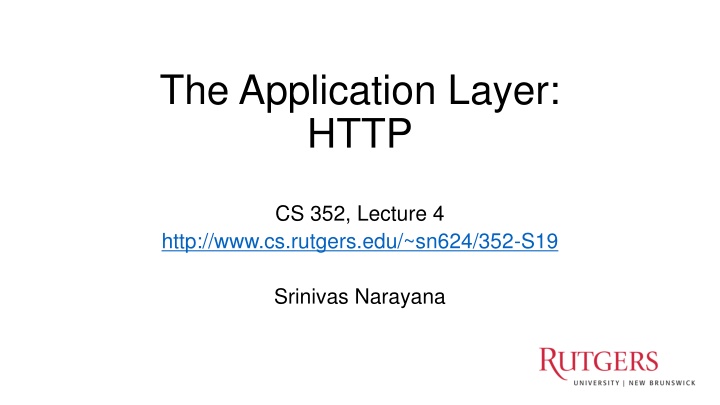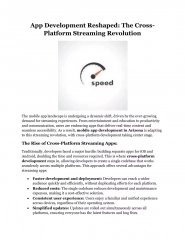
HTTP and DNS Protocols in Networking
Explore the world of Domain Name Service (DNS) and Hypertext Transfer Protocol (HTTP) in this informative content. Learn about hostname to IP address translation, caching for performance optimization, and the nature of protocols like DNS, HTTP, SMTP, and FTP. Delve into HTTP request messages, client/server models, and more to enhance your knowledge of networking basics.
Download Presentation

Please find below an Image/Link to download the presentation.
The content on the website is provided AS IS for your information and personal use only. It may not be sold, licensed, or shared on other websites without obtaining consent from the author. If you encounter any issues during the download, it is possible that the publisher has removed the file from their server.
You are allowed to download the files provided on this website for personal or commercial use, subject to the condition that they are used lawfully. All files are the property of their respective owners.
The content on the website is provided AS IS for your information and personal use only. It may not be sold, licensed, or shared on other websites without obtaining consent from the author.
E N D
Presentation Transcript
The Application Layer: HTTP CS 352, Lecture 4 http://www.cs.rutgers.edu/~sn624/352-S19 Srinivas Narayana 1
A recap: Domain Name Service (DNS) Hostname to IP address translation Hierarchical structure to scale lookups Recursive and Iterative queries Caching for performance optimization Multiple layers of indirection to delegate the lookup work 2
Some themes from DNS Request/response nature of protocols ASCII-based message structures DNS, HTTP, SMTP, FTP - simple (ASCII) protocols Higher performance using caching Scale using indirection 3
The Web Vague, but exciting
Web and HTTP: Some terms Web page consists of objects Object can be HTML file, JPEG image, video stream chunk, audio file, Web page consists of base HTML-file which includes several referenced objects Each object is addressable by a URL Example URL: www.cs.rutgers.edu/~netid/picture.jpeg path name host name 5
HTTP overview HTTP: hypertext transfer protocol client/server model Client: browser that requests, receives, displays Web objects Server: Web server sends objects in response to requests HTTP 1.0: RFC 1945 HTTP 1.1: RFC 2068 PC running Explorer Server running Apache Web server Mac running Navigator 6
HTTP messages: request message HTTP request message: ASCII (human-readable format) request line (GET, POST, HEAD commands) GET /somedir/page.html HTTP/1.1 Host: www.someschool.edu User-agent: Mozilla/4.0 Connection: close Accept-language:fr header lines Carriage return, line feed indicates end of message (extra carriage return, line feed) 7
Client server connection DNS Hostname IP address Host name IP Address http messages 8
HTTP request message: general format http://www.w3.org/Protocols/rfc2616/rfc2616-sec14.html#sec14 9
Method types GET PUT Get the file specified in the path URL field in entity body uploads file in entity body to path specified in URL field DELETE deletes file specified in the URL field POST accept the entity enclosed in the entity body as a new subordinate of the resource identified by the URL field HEAD asks server to leave requested object out of response 10
Uploading form input: GET and POST GET method: Entity body is empty Input is uploaded in URL field of request line POST method: Web page often includes form input Input is uploaded to server in entity body Example: http://site.com/form?first=jane&last=doe Posted content not visible in the URL Free form content (ex: images) can be posted since entity body interpreted as data bytes 11
Example: Client POST request POST /cgi-bin/rats.cgi HTTP/1.0 Referer: http://nes:8192/cgi-bin/rats.cgi Connection: Keep-Alive User-Agent: Mozilla/4.73 [en] (X11; U; Linux 2.2.12-20 i686) Host: nes:8192 Accept: image/gif, image/x-xbitmap, image/jpeg, image/pjpeg, image/png, */* Accept-Encoding: gzip Accept-Language: en Accept-Charset: iso-8859-1,*,utf-8 Content-type: application/x-www-form-urlencoded Content-length: 93 Account=cs111fall&First=Alice&Last=White&SSN=123456789&Bday=01011980&State=CreateAccount 12 http://www.w3.org/Protocols/rfc2616/rfc2616-sec14.html#sec14
HTTP response message: general format Unlike HTTP request, No method name 13
HTTP message: response message status line (protocol status code status phrase) HTTP/1.1 200 OK Connection: close Date: Thu, 06 Aug 1998 12:00:15 GMT Server: Apache/1.3.0 (Unix) Last-Modified: Mon, 22 Jun 1998 ... Content-Length: 6821 Content-Type: text/html data data data data data ... header lines data, e.g., requested HTML file 14
HTTP response status codes In first line in server->client response message. A few sample codes: 200 OK request succeeded, requested object later in this message 301 Moved Permanently requested object moved, new location specified later in this message (Location:) 400 Bad Request request message not understood by server 404 Not Found requested document not found on this server 505 HTTP Version Not Supported 15
Try out HTTP (client side) for yourself! 1. Telnet to your favorite Web server: Opens TCP connection to port 80 (default HTTP server port). Anything typed in sent to port 80 at www.eden.rutgers.edu telnet web.mit.edu 80 2. Type in a GET HTTP request: By typing this in (hit carriage return twice), you send this minimal (but complete) GET request to HTTP server GET / HTTP/1.1 Host: web.mit.edu 3. Look at response message sent by HTTP server! 16
Additional details about HTTP Persistent vs. Nonpersistent HTTP connections Cookies (User-server state) Web caches 17
Recall the Internet protocol stack Application HTTP HTTPS FTP SIP RTSP Transport UDP TCP Network IP Host-to-Net X.25 802.11 ATM
HTTP connections Non-persistent HTTP At most one object is sent over a TCP connection. Persistent HTTP Multiple objects can be sent over single TCP connection between client and server. HTTP/1.0 uses nonpersistent HTTP HTTP/1.1 uses persistent connections in default mode TCP is a kind of reliable communication service provided by the transport layer. It requires the connection to be set up before data communication. 19
Non-persistent HTTP 1a. HTTP client initiates TCP connection to HTTP server 1b. HTTPserver at host accepts connection, notifying client Suppose user visits a page with text and 10 images. 2. HTTP client sends HTTP request message 3. HTTP server receives request message, replies with response message containing requested object time 20
Non-persistent HTTP (contd.) 4. HTTP server closes TCP connection. 5. HTTP client receives response message containing html file, displays html. Parsing html file, finds 10 referenced jpeg objects time 6. Steps 1-5 repeated for each of 10 jpeg objects 21
HTTP Response time Definition of RTT: time to send a small packet to travel from client to server and back. Sum of propagation and queueing delays. Response time: one RTT to initiate TCP connection one RTT for HTTP request and first few bytes of HTTP response to return file transmission time total = 2RTT + transmit time initiate TCP connection RTT request file time to transmit file RTT file received time time 22
Persistent vs. Non-persistent Non-persistent HTTP issues: requires 2 RTTs per object Browsers can open parallel TCP connections to fetch referenced objects Persistent HTTP server leaves connection open after sending response subsequent HTTP messages between same client/server sent over open connection 23
HTTP: User data on servers? So far, HTTP is stateless The server maintains no information about past client requests What can state about the user @ the server bring? authorization shopping carts recommendations user session state 24
Cookies: Keeping user memory client server usual http request msg Cookie file server creates ID 1678 for user usual http response + Set-cookie: 1678 ebay: 8734 Cookie file usual http request msg cookie: 1678 cookie- specific action amazon: 1678 ebay: 8734 usual http response msg one week later: usual http request msg cookie: 1678 Cookie file cookie- spectific action amazon: 1678 ebay: 8734 usual http response msg 25
Summary of cookies Four components: 1. cookie header line of HTTP response message 2. cookie header line in HTTP request message 3. cookie file kept on user s host, managed by user s browser 4. back-end database at Web site Client and server collaboratively track and remember the user s state. 26
Cookies and Privacy Aside Cookies and privacy cookies permit sites to learn a lot about you you may supply name and e-mail to sites 27
Web caches (proxy server) Web caches: Machines that remember web responses for a network Why cache web responses? Reduce response time for client requests Reduce traffic on an institution s access link 28
Web caches (proxy server) You can configure a HTTP proxy on your laptop s network settings. If you do, your browser sends all HTTP requests to the proxy (cache). Hit: cache returns object Miss: cache requests object from origin server caches it locally and returns it to client Clients Web Server (also called origin server in this context) GET foo.html GET foo.html Proxy Server The Internet Store foo.html on receiving response 29
Web Caches: how does it look on HTTP? server cache Conditional GET guarantees cache content is up-to-date while still saves traffic and response time whenever possible HTTP request msg If-modified-since: <date> object not modified HTTP response HTTP/1.0 304 Not Modified Date in the cache s request is the last time the server provided in its response header last modified HTTP request msg If-modified-since: <date> object modified HTTP response HTTP/1.0 200 OK <data> 30
Content Distribution Networks (CDN) A global network of web caches Provisioned by ISPs Or content providers! (Netflix, google, ) Uses Reduce bandwidth requirements of content provider Reduce $$ of maintaining servers Reduce traffic on the link to the content provider Improve response time to user for that service 31
Without CDN DOMAIN NAME IP ADDRESS www.yahoo.com 98.138.253.109 cs.rutgers.edu 128.6.4.2 www.google.com 74.125.225.243 www.princeton.edu 128.112.132.86 Cluster with Yahoo s origin servers Huge bandwidth requirements Large propagation delays to reach users So, distribute content to geographically distributed cache servers. Often, use DNS to redirect request to users to copies of content! 98.138.253.109 32
CDN terms Origin server Server that holds the authoritative copy of the content CDN server A replica server owned by the CDN provider CDN name server A DNS like name server used for redirection Client
DOMAIN NAME IP ADDRESS With CDN www.yahoo.com 124.8.9.8 (NS of CDN) cs.rutgers.edu 128.6.4.2 www.google.com 74.125.225.243 www.princeton.edu 128.112.132.86 CDN Name Server (124.8.9.8) Scale through indirection to CDN name server. Custom logic to map ONE domain name to one of many IP addresses! DOMAIN NAME IP ADDRESS www.yahoo.com 12.1.2.3 www.yahoo.com 12.1.2.4 www.yahoo.com 12.1.2.5 www.yahoo.com 12.1.2.6 12.1.2.3 12.1.2.4 CDN servers 12.1.2.6 12.1.2.5 98.138.253.109 Origin server Client 34
Themes from HTTP Request/response nature of protocols Headers determine the actions of all the parties of the protocol ASCII-based message structures Higher performance using caching Scaling using indirection These principles form of the basis of the web that we enjoy today! 35






















